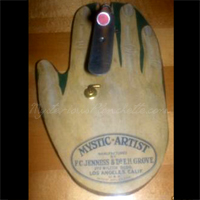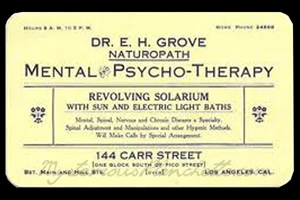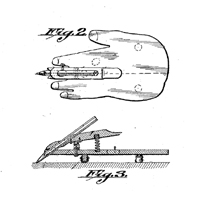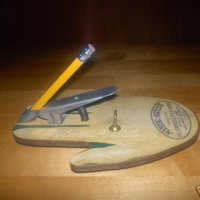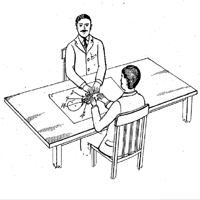Many talking board patents exist with no tangible evidence that an item ever left the drawing board to become a product in the real world. Such was the assumption of the "Mystic Artist" planchette, until an online auction finally revealed its existence. We only have a little information on the two fellows whose emblazoned names are imprinted on the the device. We know that Frank C. Jenness of Los Angeles is credited as the inventor, having made a "significant improvement" to traditional planchettes with the pencil retaining device, and filed for a patent on May 11, 1921. The final patent, approved about two years later, states Dr. Elias H. Grove as co-assignor. We know little of either man. Census records list Frank Jenness as a solicitor and advertiser, and we know he compiled and edited an "Annual Souvenir" booklet for the Los Angeles Police Relief Association in 1911. He was approaching 60 years of ago when the Mystic Artist was produced.
Dr. Elias Grove was close to the same age, and his profession provides more of a connection to the "mystic arts." Records indicate Dr. Grove was a general physician when living with his family in Ohio in the 1910s, but after relocating to LA, he is listed as a "sun bath" provider, and his business cards from the 1930s lists his services as "Mental Psycho-Therapy" and his business as a "Revolving Solarium with Sun and Electric Light Beds." In other words, Dr. Grove ran an early version of the tanning salon! This fad had grown in popularity in the 1920s, and finally exploded in the 1930s, with doctors proclaiming the healing benefits of ultra-voilet light provided through small portable buildings made of a frosted plastic material called Celotex that supposedly filtered more ultra-violet light in than regular windows, and the whole shed revolved to ensure constant bathing in the sun's healing rays.
The duo's planchette is very reminiscent of the Chad Valley "Hand of Fate" board, though it is unknown if the British board in any way inspired the two in the manufacture of their own planchette. The board is simply cut with sharp edges from either poor quality wood or a composite masonite-type material, and the top is printed with a lithograph of a hand. The maker's names appear in an oval logo toward the bottom of the board, along with their LA address and the plank's "Mystic Artist" moniker.
The most unique feature of the plank is also the reason for its patenting. A spring-loaded aluminum lever serves as the board's pencil retainer. According to the inventors, this provided "yieldability" for the plank's stylus, facilitated easier use, and allow the planchette to be "turned off." The board is unusual for a planchette in that it has three turned-wood castors, more like a talking board planchette than a true automatic writer. Rather than wheels, the castors have felt-covered feet, again more like a traditional talking board pointer. Due to the presence of the small brass L-hook that was meant to hold the pencil lever down in inoperative position, it may be that the inventors intended the device to also be used as a talking board pointer, and with a surge in popularity in ouija at the time, it was probably a wise decision.
The Mystic Artist is a neat planchette. It seems more in the spirit of later inventions, and has the look and feel of a device from a slightly more modern era-perhaps the 1940s, rather than the early 20s. It is unknown how popular the device proved or how many were produced, but we hope to see more surviving specimens to examine!







